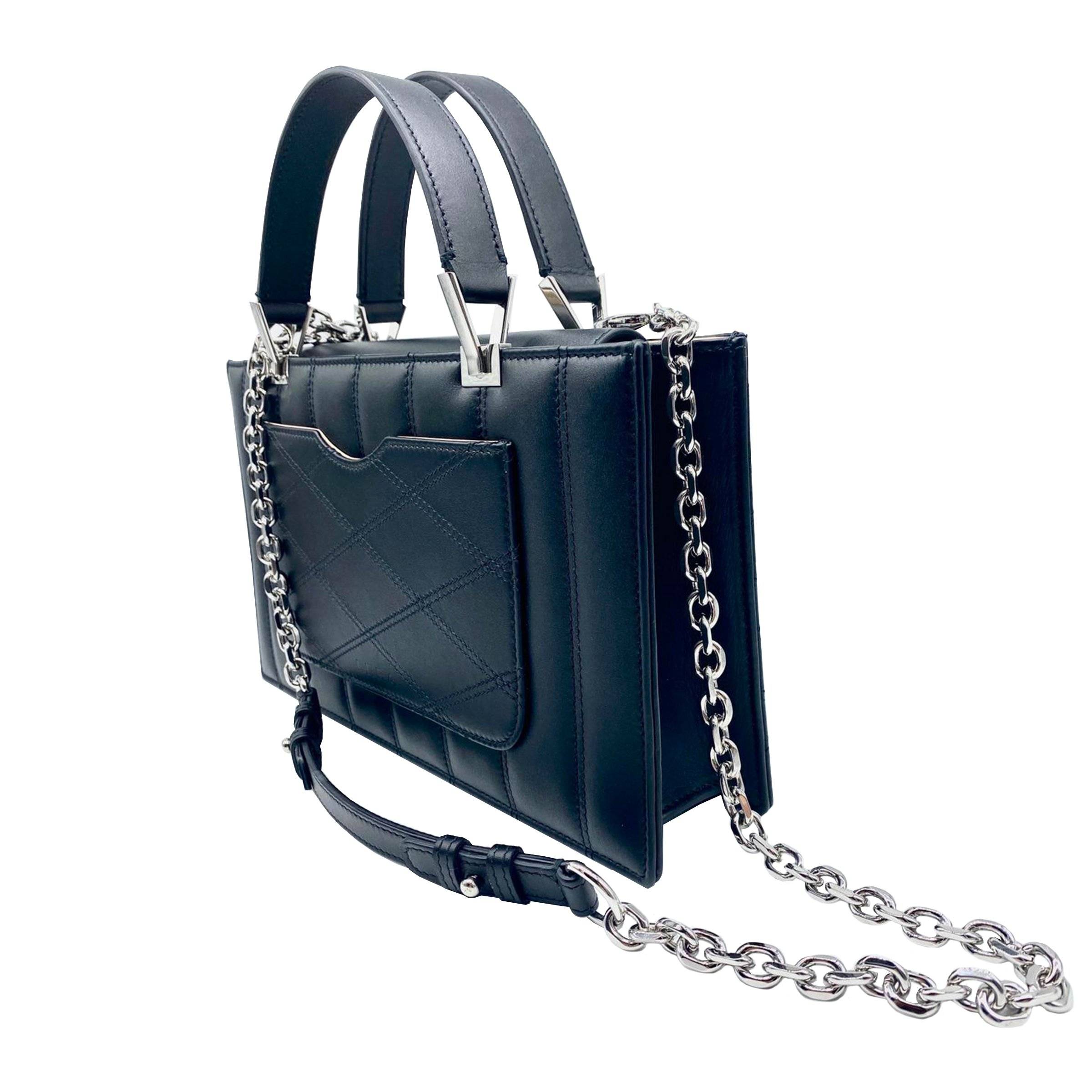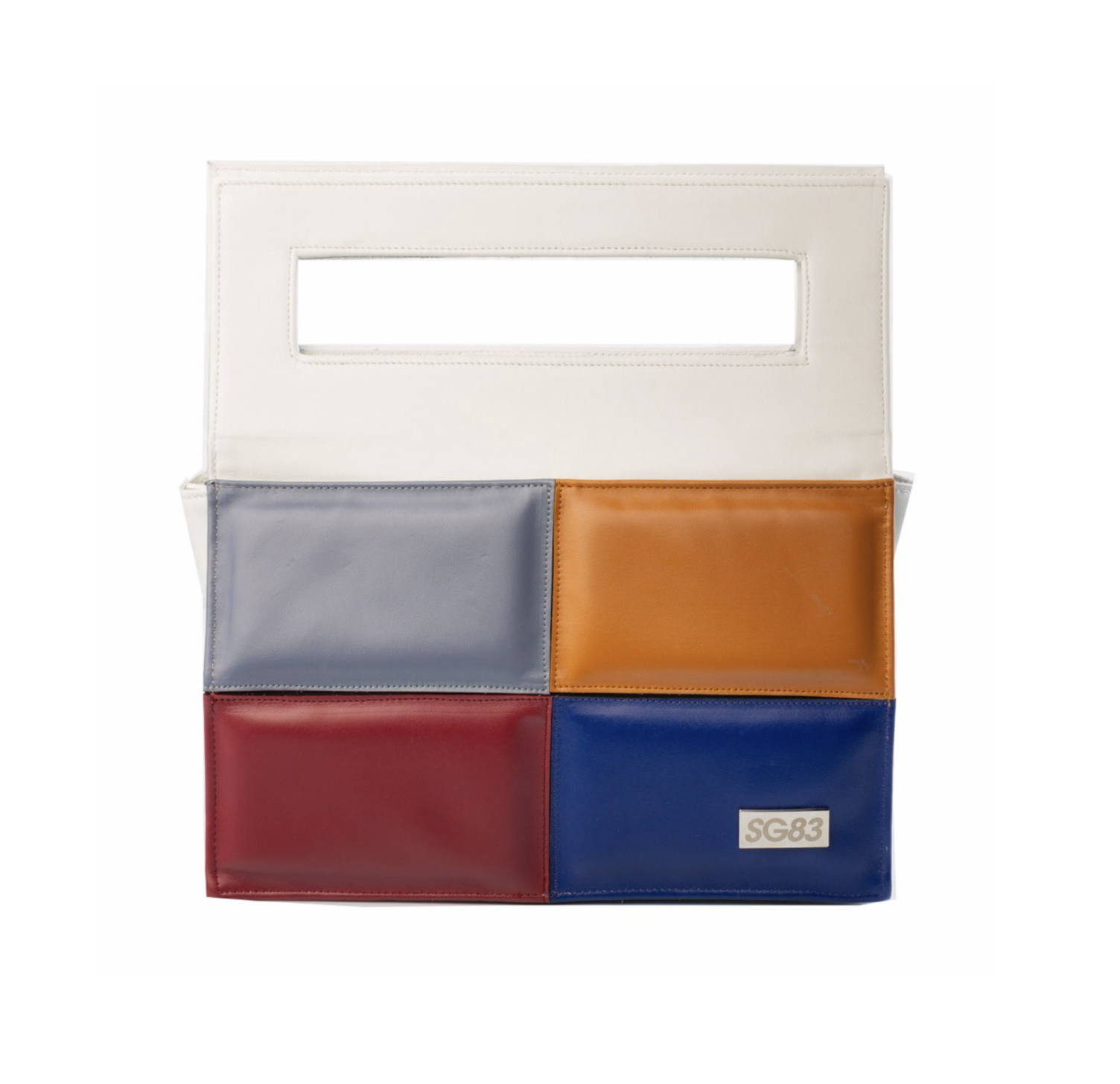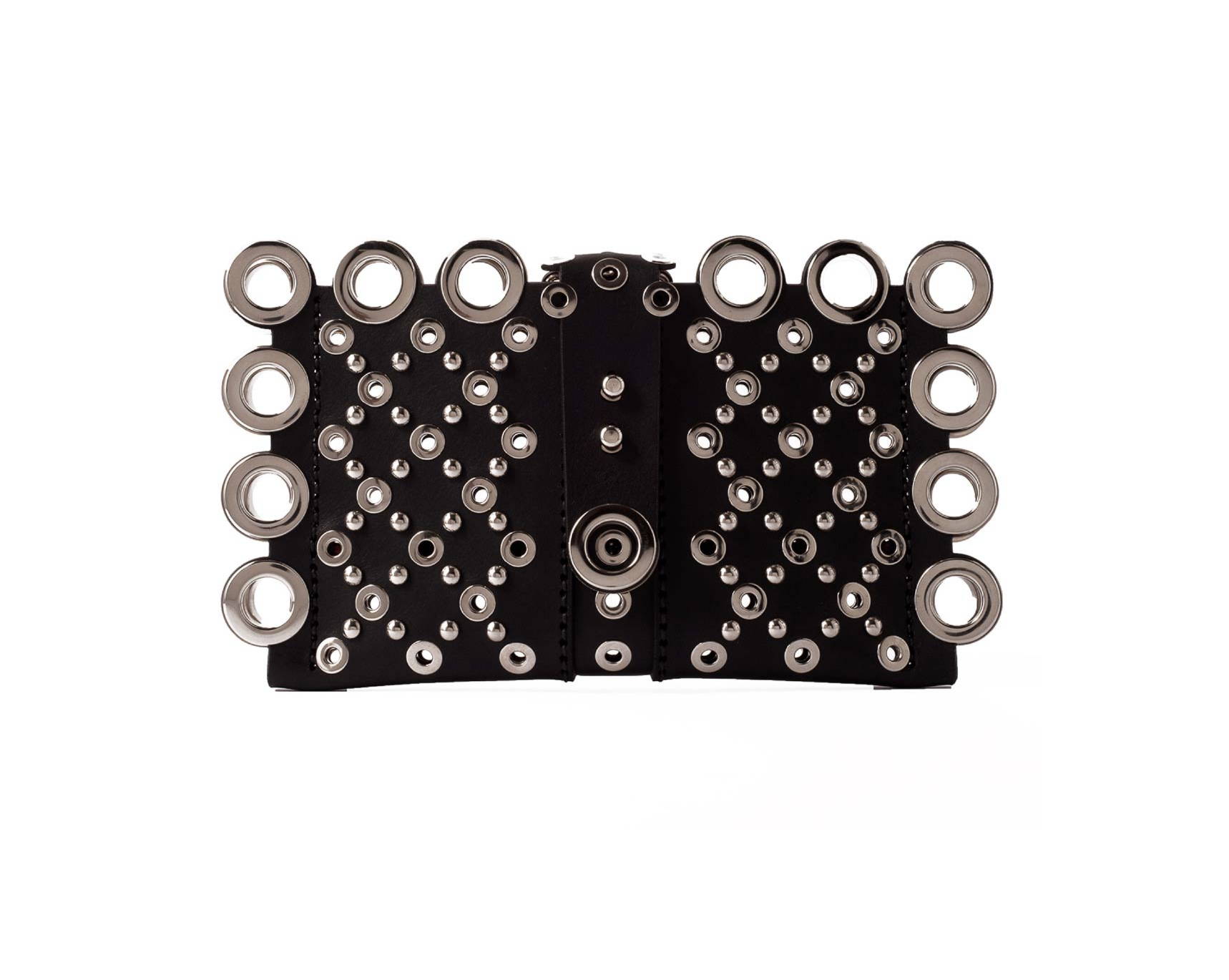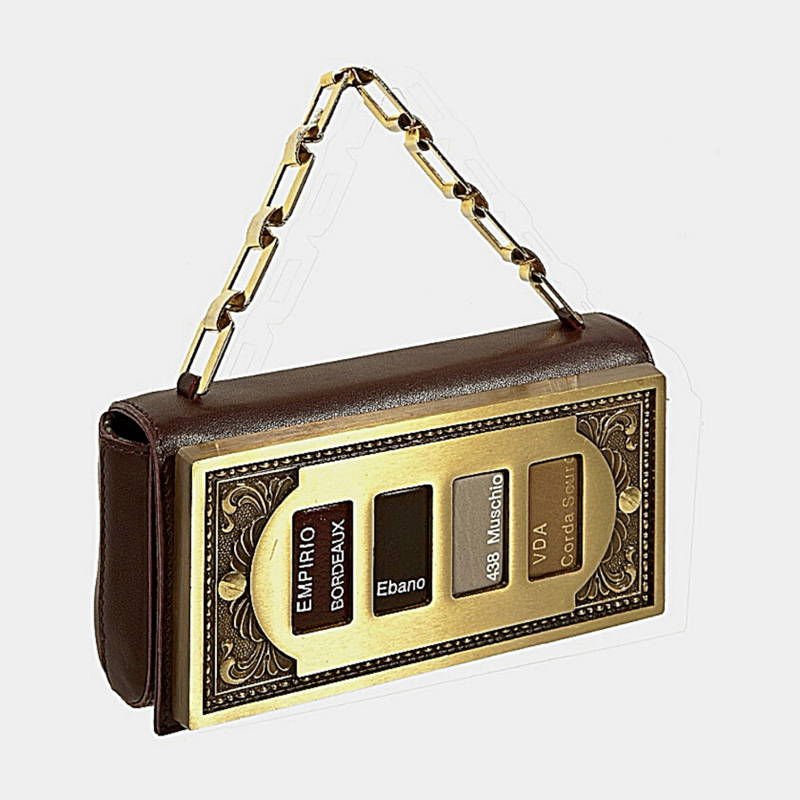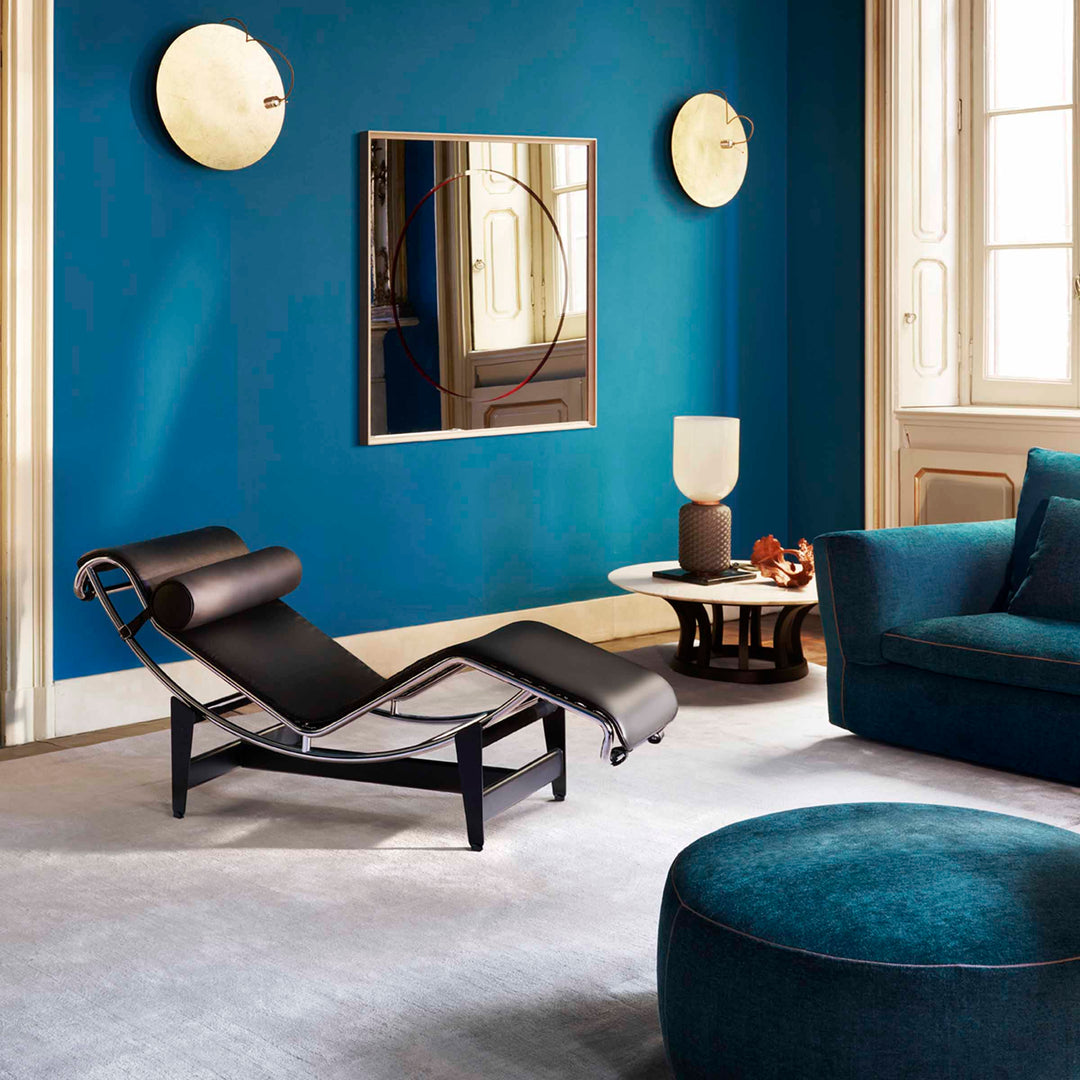HISTOIRES DE DAMES ET DE LEURS SACS À MAIN
LA LISTE #5
L'édition de ce mois de The List est entièrement consacrée aux sacs à main. Selon une recherche publiée par le Daily Mail, le sac à main moyen pèse 2,5 kg. Je suppose que le mien pèse souvent encore plus.

Image fixe du film Mary Poppins ; réalisé par Robert Stevensons ; USA ; 1964 ; 138 minutes. Ci-dessous : un sac en tapis comme celui de Mary Poppins
C'est une sorte d'extension de mon bras, une partie indispensable de moi, et une trousse à outils portable qui contient un peu de tout. Qu'il soit élégant, usé, débordant, assorti à une tenue, à la mode ou simplement fonctionnel, je change souvent de sac, mais ils servent toujours le même but.
Peut-être que le sac le plus célèbre de tous les temps est le sac en tapis de Mary Poppins. Il y a des gens comme moi qui iraient jusqu'à renoncer à un sac Hermès Kelly en échange du gigantesque sac en tapis que la célèbre nounou a porté à l'écran en 1964 grâce à Walt Disney (le film était basé sur la série de livres de l'écrivaine Pamela Lyndon Travers, Mary Poppins).
Son sac en tapis est énorme, et il n'y a aucune limite à ce qu'il peut contenir.
Qui ne voudrait pas de ce sac magique en tapis ? Après tout, on n'a jamais assez de sacs à main, et il est impossible de ne pas toujours courir après un nouveau.
Moi-même, je rêve de posséder le sac en tapis de Mary depuis 1964.
J'ai toujours été attirée par les sacs à main de ma mère quand j'étais petite fille, et j'aime encore découvrir des légendes et apprendre des anecdotes intéressantes autour des sacs à main, ainsi que regarder de vieilles photographies de femmes élégantes les portant.
Alors, sans plus tarder, commençons par la liste de ce mois-ci.
QUE CONTIENT MON SAC À MAIN ?
Ce projet cherche à élucider un grand mystère : que portent exactement les femmes dans leurs sacs à main ?
Pourquoi les sacs à main pèsent-ils toujours autant ?
Nous, les femmes, ne sommes pas vraiment connues pour voyager léger : quand je voyage, je vois des hommes avec un minimum de bagages ou un simple sac à dos, alors que moi, en revanche, je transporte assez d'objets pour remplir une maison. Et comme la vraie championne de Tetris que je suis, je parviens à tout faire rentrer parfaitement.
Sarah Benton a demandé à 20 femmes de différents âges et professions de décrire ce qu'elles ont dans leur sac à main. Le résultat fut une exposition unique qui a mis en lumière une recherche anthropologique fascinante : la preuve que la personnalité d'une femme peut être décrite en fonction de ce qu'elle porte dans son sac. Mais est-ce les objets qui choisissent le sac, ou le sac qui convient aux objets ? C'est le dilemme éternel.

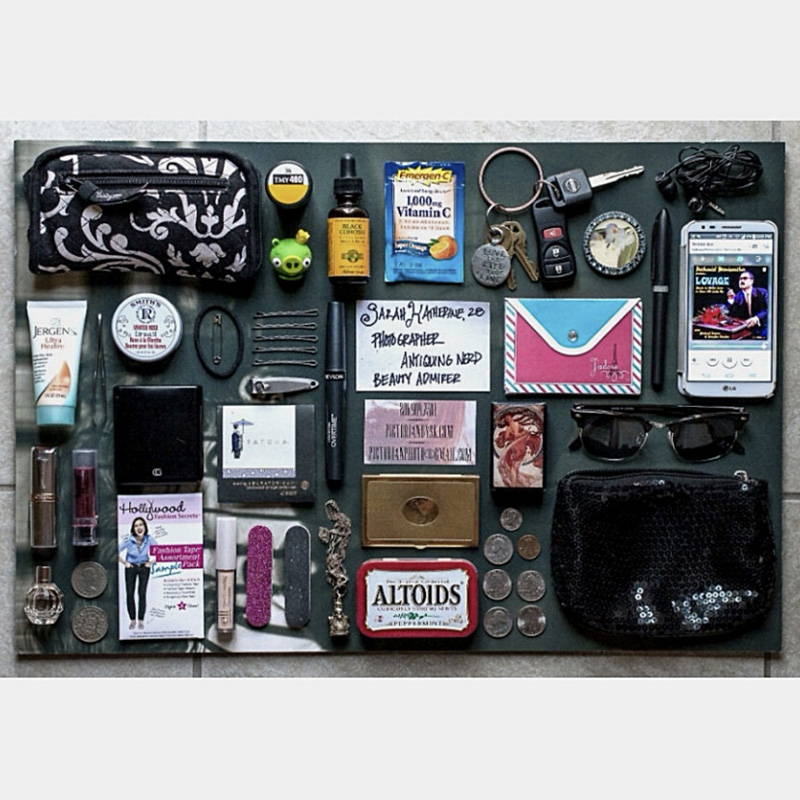

Sarah Benton ; projet photographique In Her Handbag ; USA ; 2014
Photographies de l'exposition :
Kristy Carey, 37 ans, directrice créative
Sarah Benton, 56 ans, photographe
Stephanie Collard, 31 ans, femme au foyer
CASTING D'UNE ACTRICE BASÉ SUR LES OBJETS DANS SON SAC
C'est un charmant petit court métrage avec une fin surprise. Je ne révélerai pas la fin, mais je dirai qu'un sac à main et son contenu racontent l'histoire du protagoniste principal du film.
Dans le court métrage, Emilie Muller est une actrice en herbe à qui un réalisateur demande de révéler le contenu de son sac à main. Elle décrit avec enthousiasme chaque objet, racontant des histoires autour de photos, de livres et de souvenirs d'enfance. Avec les objets plus classiques dans son sac comme une bourse à pièces, un livre et un stylo, il y a aussi une pomme, un billet d'avion, une bague et des cartes postales. Tous sont des objets qu'Emilie utilise comme source d'inspiration pour parler d'elle-même ou pour discuter d'amour, de séduction et d'amitié.
La réalité et la fantaisie se heurtent dans un tourbillon d'anecdotes et de souvenirs. Une illusion émotionnelle pour le spectateur, car qui est vraiment Emilie ? Peut-être une vraie actrice.
Regardez ce charmant petit court métrage ici : https://www.youtube.com/watch?v=Om8e9494G-Q

Emilie Muller ; court métrage de Yvon Marciano ; France ; 1993 ; 21 minutes
PROTOCOLE ET LE SAC ROYALE
La reine Elizabeth II est fidèle à la marque britannique Launer depuis un demi-siècle. Et bien qu'il puisse sembler qu'elle porte toujours le même sac à main, elle utilise en réalité au moins trois modèles différents : le Royale (très approprié) ; le Traviata ; et un troisième qui a été créé spécialement pour elle et qui n'a pas de nom.
Selon le Telegraph, la Reine possède au moins 200 sacs à main. Comme l'a révélé l'historien Hugo Vickers, ce n'est pas tant une question de style que de sécurité. Elle utilise son sac pour envoyer des signaux à son personnel : par exemple, si elle le déplace d'une main à l'autre, cela signifie qu'elle veut mettre fin à une conversation.
La Première ministre britannique Margaret Thatcher utilisait également le même type de sac à main que la Reine, mais elle l'a transformé en une arme de pouvoir dans un monde d'hommes. Il pouvait sembler être un simple sac inoffensif au bras d'une femme ordinaire et respectable, mais ensuite elle le posait sur la table et sortait ses « munitions ». Cynthia Crawford, son assistante, a déclaré : « Elle sortait des feuilles de papier avec des discours, trouvant un moyen de raccourcir les réunions trop longues ou sans conclusion ».


SACS À MAIN MYSTÉRIEUX DES DIEUX

Bas-relief de la divinité Nisroch avec un objet ressemblant à un sac à main ; chapiteau de Nimrud, 883-859 av. J.-C. ; Palazzo Reale
Le « sac des dieux » est un symbole mystérieux que l'on retrouve dans de nombreuses images à travers l'histoire et qui a une signification profonde.
L'objet est toujours tenu par des entités liées au concept de pouvoir, de connaissance et au mystère de l'existence. Le savoir est pouvoir et se transmet de génération en génération à tous ceux qui en sont dignes. Le « sac » est un moyen de ce passage, symbolisant ce transfert d'un individu à un autre, mais c'était aussi un réceptacle qui contenait le secret de l'existence de la matière.
Le sac pouvait aussi être une icône de l'ancien « sac de chasse » qui suggérait la signification de richesse et d'abondance sous toutes ses formes. Aujourd'hui, les sacs à main sont des objets fortement symboliques liés à la psychologie et aux émotions féminines les plus profondes et intenses, mais aussi un signe incontournable d'appartenance sociale et culturelle.
LES FEMMES DE LA WIENER WERKSTATTE
À l'aube du modernisme, 200 femmes ont apporté leur contribution artistique à la Wiener Werkstätte. La communauté de design a été fondée en Autriche en 1903 par Joseph Hoffmann, Koloman Moser et Fritz Wärndorfer, qui étaient des défenseurs de « l'œuvre d'art totale ».
Le mouvement visait à réformer l'artisanat artistique, en comblant le fossé entre artisans et artistes ainsi qu'entre exécution et conception, sur la base de critères stricts de qualité.
Ils ont fondé une école qui a contribué à poser les bases des mouvements ultérieurs, y compris le Bauhaus allemand. Dans ses ateliers de céramique, d'orfèvrerie, de tissage, de couture et de verrerie, la Wiener Werkstätte produisait des objets conçus pour la vie quotidienne.
En 1910, la Wiener Werkstätte a fondé son département textile, suivi en 1911 par un département de mode. Ils ont produit des modèles de sacs à main avec des motifs jamais vus auparavant. Les projets étaient très centrés sur l'étude et la conception de nouvelles textures. Tout cela reposait sur un rejet fort des anciens goûts, du naturalisme, de l'académisme et de la « respectabilité » typique de l'époque.
Les femmes étaient les protagonistes d'une révolution culturelle qui peinait à s'imposer à cette époque. Quelques décennies supplémentaires allaient s'écouler avant que les résultats de ce mouvement ne deviennent clairs, et que les femmes soient reconnues comme les actrices principales de cette révolution.


Gudrun Baudisch, Charlotte Billwiller, Mathilde Flögl, Susi Singer, Jutta Sika ; Vienne, Autriche ; vers 1907
COCO CHANEL ET LE PREMIER SAC BANDOULIÈRE

Photographie de Coco Chanel avec le premier sac 2.55 ; France ; 1955
Le sac 2.55 – dont le nom fait référence à février 1955 – est l'un des sacs à main les plus célèbres et copiés au monde.
Grâce à la créativité de Coco Chanel, elle fut l'une des personnes qui ont contribué à révolutionner le concept de féminité et à éliminer le goût amer de la Belle Époque française.
Audacieuse, non-conformiste et ingénieuse, elle a créé un nouveau style de mode pour les femmes qui, à cette époque, s'émancipaient des espaces domestiques et se distinguaient dans le monde du travail.
Coco a compris le besoin de la femme moderne et dynamique d'avoir les bras et les mains libres pour faire plusieurs choses à la fois. Elle a donc attaché une bandoulière à un sac rectangulaire pour pouvoir le porter à l'épaule. Le modèle original était en tissu jersey noir et bleu, remplacé plus tard par du cuir matelassé avec une fermeture pivotante que tout le monde a commencé à imiter.
SACS INCONTOURNABLES
L'époque victorienne a vu naître l'industrie du sac à main en Europe, et surtout en France, où des maisons de mode comme Hermès et Louis Vuitton ont commencé à apparaître.
Dans les années 1930, Robert Dumas, qui a succédé à Émile Hermès à la tête de la maison de mode, a créé le célèbre sac Kelly, à partir d'une forme trapézoïdale, deux soufflets triangulaires sur les côtés, un rabat découpé et une poignée. Ce sac est fabriqué avec le plus grand soin et précision par un seul artisan qui consacre de 18 à 24 heures pour l'assembler impeccablement.
À la fin des années 1950, Grace Kelly, star hollywoodienne et princesse de Monaco, a été photographiée avec le sac, qui couvrait son ventre, dissimulant le fait qu'elle était enceinte de son premier enfant, Carolina. D'où le nom « Kelly ». Premier sac « it » de l'histoire, c'est un sac prestigieux et exclusif, extrêmement difficile à obtenir, avec d'interminables listes d'attente.
Hermès a ensuite lancé un modèle similaire, inspiré des sacs en forme de selle que la maison de mode produisait au XIXe siècle. Pourtant, celui-ci était moins structuré et plus souple, conçu pour l'actrice et chanteuse anglaise Jane Birkin, qui avait demandé un sac discret pour le week-end. Le sac Birkin a rencontré un succès retentissant.
Aujourd'hui, les sacs Kelly et Birkin sont souvent recréés de manière à confirmer leur unicité et leur exclusivité.
Une anecdote intéressante : le sac original de Jane Birkin a été vendu aux enchères en avril 2011 pour collecter des fonds en faveur des victimes du tremblement de terre et du tsunami de Tōhoku en 2011.
LE SAC « IT » EXISTE-T-IL ENCORE ?
Les maisons de mode de luxe ont toujours dédié leurs collections et accessoires les plus importants à des femmes célèbres. Et ce sont souvent ces femmes qui inspirent un design particulier ou qui trouvent une manière originale de le porter, entraînant des changements dans les collections.
Il existe une longue histoire de sacs « it » nommés d'après des icônes de style. C'est un phénomène que l'on observe sur les podiums et à travers l'histoire, qui s'inspire de la culture et des changements générationnels. Il ne s'agit plus de goût ou de fonctionnalité, mais plutôt de quelque chose qui touche l'inconscient, reflétant le désir et les apparences.
Mais nous devons nous demander aujourd'hui, qu'est-ce qui fait le succès d'un accessoire ? L'ère du sac « it » est-elle révolue ? Que voulons-nous qu'il reflète de nous ? Qui sont nos modèles ?
Nos valeurs ont certainement changé aujourd'hui, un exemple étant notre perception de l'environnement et des enjeux environnementaux, y compris dans le domaine de la mode. Il ne fait aucun doute que le changement est en marche.



Sac BB (Brigitte Bardot) de Lancel ; France ; 2010
Sac Sofia (Loren) par Salvatore Ferragamo ; Italie ; 2009
Sac Jackie O par Gucci ; Italie ; 1961
LE SAC BAGONGHI
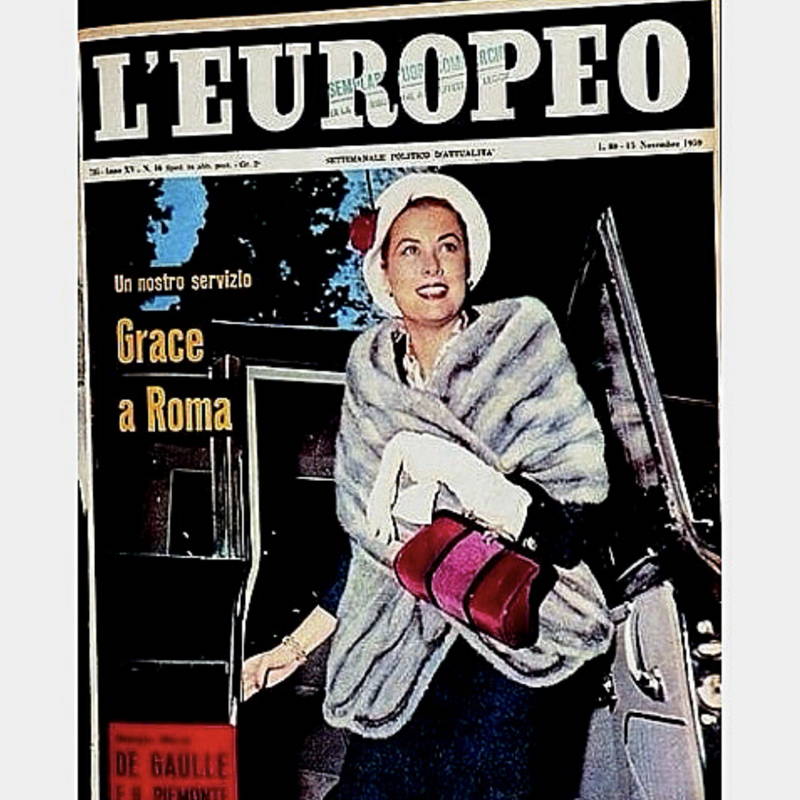
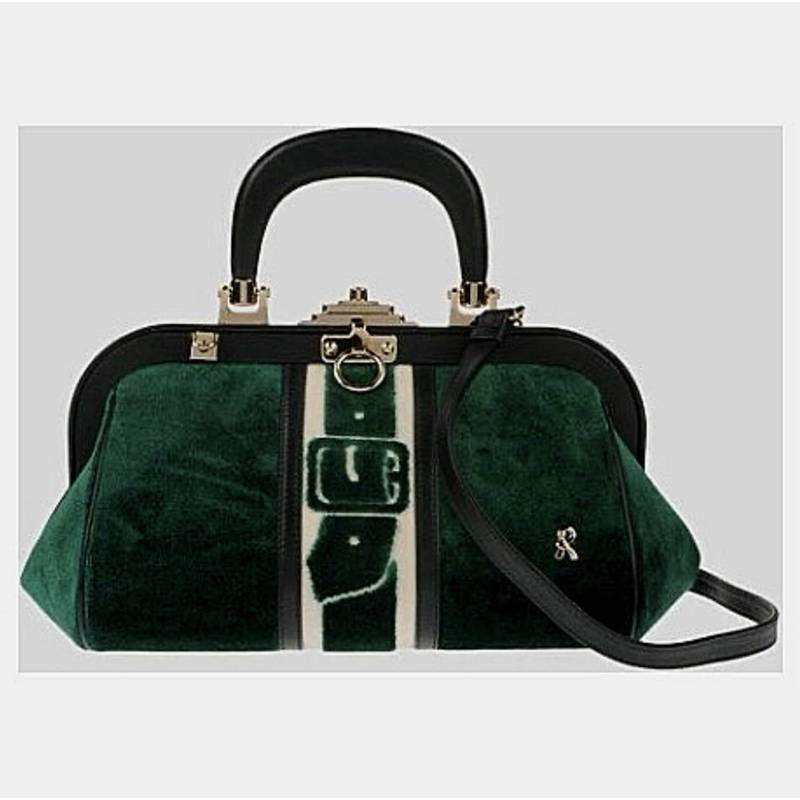
Couverture du magazine L’Europeo avec la princesse Grace de Monaco en 1959, avec un sac Bagonghi qui semble presque sortir de l'image. Ci-dessous : le sac Bagonghi ; Venise, Italie ; 1948
Le sac Bagonghi a été nommé d'après un mot italien obsolète utilisé pour décrire les travailleurs du cirque, en raison de sa forme inhabituelle. Il a été conçu et produit par la styliste vénitienne révolutionnaire Roberta di Camerino en 1948, qui fut la première personne dans la mode à rompre avec le duo sac-chaussure, qui à l'époque devait être assorti. Elle fut également la première à inventer les défilés de mode et à y faire venir des acteurs, des danseurs et des animaux.
Elle était un génie créatif, et juste après la Seconde Guerre mondiale, elle a créé un sac à main à double usage qui pouvait passer du jour à la nuit en un clin d'œil. Avec sa « couverture » en velours (comme elle l'appelait), c'était un sac de jour. Mais lorsque la couverture était retirée, le sac se transformait en sac de soirée en cuir foncé. Initialement, les détails métalliques du sac étaient réalisés par les mêmes artisans qui façonnaient les détails métalliques des gondoles vénitiennes.
LE SAC NYLON PRADA
Tout a commencé avec la création d'un sac à dos noir en 1984. La nouveauté était qu'il était produit dans un matériau inhabituel pour un sac de luxe : il était en « tissu vela », une version aristocratique du tissage synthétique en polyamide inventé par Wallace Hume Carothers dans les laboratoires DuPont à la fin des années 1930. Le tissu était souple, doux et scintillant, et lorsqu'il était façonné avec des techniques artisanales méticuleuses et avec l'ajout de garnitures en cuir saffiano, le matériau a rencontré un grand succès grâce à sa légèreté et sa praticité. Une collection de sacs a été immédiatement créée et a encore aujourd'hui un culte.
« Soudain, le nylon m'a paru plus intéressant que n'importe quel tissu de haute couture. J'ai décidé de l'introduire dans la collection et sur le podium. Cela a inévitablement remis en question, presque déstabilisé, la perception traditionnelle et conventionnelle du luxe. À ce jour, le nylon reste une de mes obsessions » (Miuccia Prada).

LADY DIOR


Lady D photographiée à deux occasions avec un sac Lady Dior ; Paris ; 1995. Ci-dessous : un sac de la collection Dior Lady Art
En 1995, Bernadette Chirac a offert à la princesse Diana ce célèbre sac à main, qui a immédiatement été renommé de « Chouchou » en « Lady Dior » (Lady D) en son honneur.
La première fois que Diana l'a utilisé, c'était à l'exposition Cézanne au Grand Palais à Paris. Dès lors, elle en a voulu dans différentes tailles et couleurs et ne s'en est plus jamais séparée.
Dans les années 1990, les sacs à dos et les sacs banane étaient très en vogue, et les sacs bandoulière étaient des incontournables extrêmement pratiques. Dior s'est immédiatement distingué avec un sac à main résolument élégant que les générations plus âgées comme plus jeunes adoraient porter. Le Lady Dior était différent, avec son corps compact et carré, ses poignées arrondies, et ses charms qui épellent « Dior ».
Aujourd'hui, le sac est une icône classique que l'on retrouve dans les couleurs vives et les motifs du projet Dior Lady Art, qui réinvente et transforme cet accessoire intemporel entre les mains d'artistes internationaux.
MODE : UN DIALOGUE AVEC L'ART CONTEMPORAIN
En 1896, Louis Vuitton a lancé ses célèbres sacs en toile Monogram, qui – inspirés par le design oriental de la fin de l'époque victorienne – mêlaient les initiales du fondateur (LV) à des formes de fleurs et de trèfles à quatre feuilles. C'est un motif que tout le monde reconnaît.
Au départ, Louis Vuitton a créé son « gris Trianon », ou toile Trianon grise, un nouveau matériau ciré, pour couvrir ses malles steamer car il était imperméable tout en étant léger et résistant.
La marque a été la première à produire des sacs souples, pratiques et non structurés et a été le précurseur des articles en cuir. Elle continue de mêler des influences du monde entier, comme elle l'a fait par le passé, avec des réinterprétations du Monogramme de la marque : à commencer par Takashi Murakami en 2002, puis Richard Prince en 2008, ainsi que Damien Hirst, Jeff Koons, et l'artiste dynamique et activiste Yayoi Kusama, pour n'en nommer que quelques-uns. Tout cela fait partie de l'objectif de Louis Vuitton de toujours rester à la pointe de son temps.
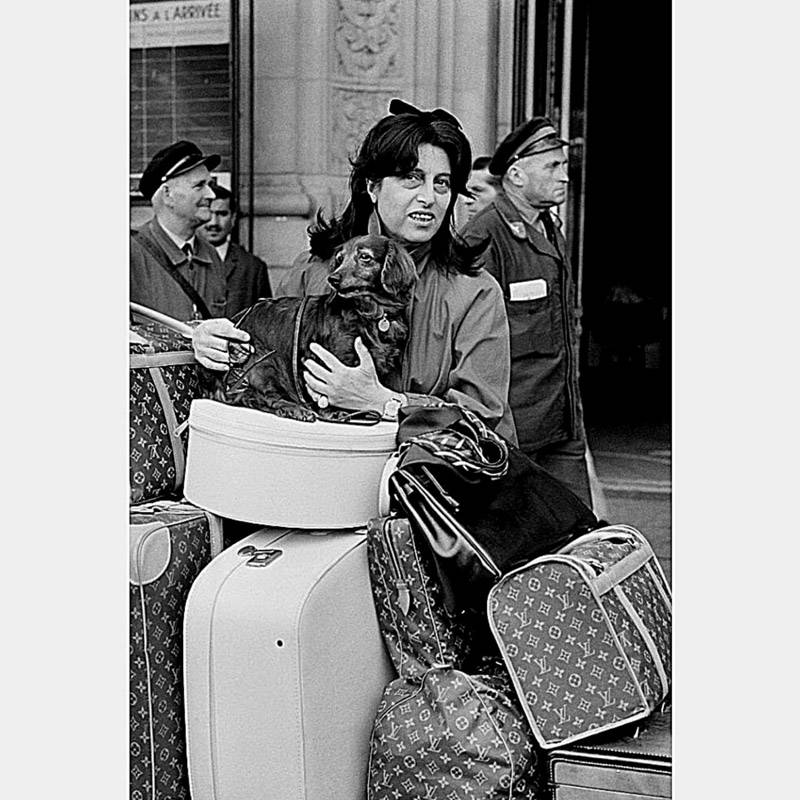

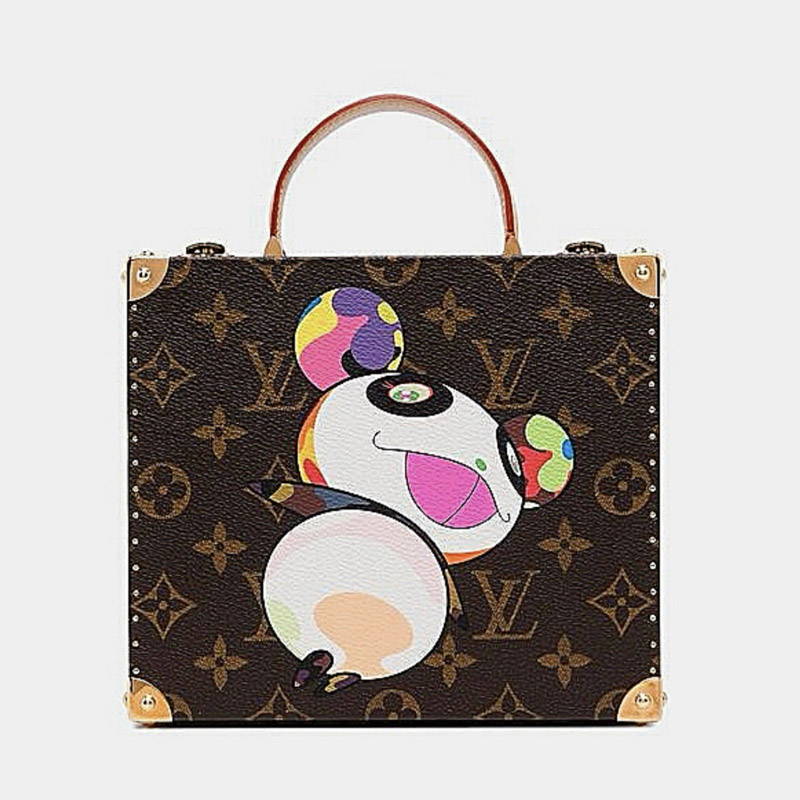

Photo de 1960 d'Anna Magnani avec des sacs et bagages Louis Vuitton
LÉGÈREMENT GRUNGE, MAIS COUTURE

Pochette Alexander McQueen ; UK ; 2003
Levez la main si vous étiez épris du phénomène Alexander McQueen. Le créateur britannique visionnaire était transgressif et choquant au point d'être appelé le « hooligan de la mode », mais c'était aussi une âme délicate. Il était l'un des poètes du XXIe siècle capable de changer la façon dont les gens percevaient non seulement la mode mais aussi les femmes.
Il était fasciné par les crânes et les a introduits dans le monde de la mode. Ses collections sont devenues une obsession, tout comme ses performances, qui dénonçaient la culture de la violence contre les femmes.
Il a réussi à mêler la couture à la contre-culture urbaine, et les styles sophistiqués au streetwear.
SACS AVEC UN THÈME
Certains sacs à main sont de véritables chefs-d'œuvre artistiques et des créations uniques en édition limitée. Ces sacs sont souvent ludiques et extravagants avec leurs formes et couleurs inattendues.
Carla Braccialini est une créatrice qui, dans les années 1980 – une époque d'excès et d'extravagance – a lancé sa collection Temi, fabriquée en Italy et inspirée par les accessoires Art déco italiens. Nous étions tous fous à l'époque de ces sacs qui étaient enfin différents, amusants, et qui parfois même aidaient à briser la glace lors des fêtes.
Aujourd'hui, un sac à main doit exprimer votre style de vie et votre personnalité, et il existe des artistes extraordinaires en Italie et dans le monde entier qui savent exactement comment vous aider à faire une déclaration unique et expressive.


Kathleen Dustin : porte-monnaie cactus. Carla Braccialini : porte-monnaie Pasta-dolce. Italy ; années 1980
SACS GÉOMÉTRIQUES




Renzo Piano ; Whitney Bag ; Max Mara ; Italy ; 2015
Zaha Hadid ; Clutch ; Perrin Paris ; France ; 2017
Issey Miyake ; Bao Bao Bag ; Japon ; 2000
Clutch Boy Brick (Lego) ; Chanel ; France ; 2013
Ces sacs sont un mélange d'ingénierie, d'architecture et de sculpture. Inspirés par des figures géométriques simples, ils sont créés avec des techniques d'origami, des découpes ou des jeux de lumière, des nervures, des structures de soutien élégantes, ou des formes qui évoquent les fondamentaux de l'architecture, des détails structurels, ainsi que des techniques et matériaux expérimentaux.
Ce sont des sacs à main que les créatifs adorent. Ils ont suscité la fascination grâce à leur esprit contemporain et à la complexité des techniques et matériaux utilisés pour les créer.
RECYCLAGE : DES DÉCHETS AU DESIGN
Le recyclage et l'économie circulaire dans la mode sont des sujets brûlants. En tant que créateurs, nous avons une énorme responsabilité, et l'avenir de l'environnement dépend de la capacité de la société à résoudre les problèmes de déchets et de pollution. Nous recyclons parce que nous nous soucions de l'avenir de ceux qui viendront après nous.
D'abord, il n'y a plus de place pour les déchets, et nos décharges se remplissent rapidement. Par exemple, d'ici 2022, l'Italie devra penser à de nouveaux espaces de stockage des déchets.
Et puisque produire des biens à partir de matières premières coûte beaucoup plus cher que de les fabriquer à partir de produits recyclés, nous devons préserver les ressources naturelles pour les générations futures. Le recyclage réduit le besoin en matières premières et consomme moins d'énergie, préservant ainsi des ressources précieuses.
Et puis il y a le fait que la mode durable ne se limite pas au coton biologique ou aux vêtements d'occasion. Il s'agit de profiter des matériaux déjà disponibles et qui méritent une nouvelle vie. Les déchets qui ne peuvent pas être éliminés peuvent être transformés en quelque chose de nouveau.
Le monde de la mode est bien en avance sur celui du design de mobilier en matière de recyclage et d'upcycling.
Par exemple, la marque Carmina Campus d'Ilaria Venturini Fendi en est un parfait exemple, avec son utilisation de matériaux inhabituels créés à partir d'objets non recyclables, y compris un sac qui intègre des plaques d'interrupteurs du fabricant BTicino.
Les produits créés grâce à ces choix écologiques ne sont pas seulement éthiques et durables, mais aussi spéciaux et uniques.
COMMENT RECONNAÎTRE UN VRAI SAC IKEA D'UN BALENCIAGA
Ikea a tenu à faire savoir au monde qu'il n'existe qu'un seul sac Frakta, et a répondu sur un ton ironique au lancement par Balenciaga d'un sac qui ressemble beaucoup au sac de courses bleu le plus célèbre au monde.
Il y a aussi eu la brillante campagne, menée par le directeur créatif Johan Holgrem de l'agence suédoise ACNE, qui expliquait comment reconnaître un vrai sac Frakta :
« Comment identifier un sac IKEA Frakta original : 1) Secouez-le : s'il fait du bruit, c'est le vrai. 2) Multifonction : il peut transporter du matériel de hockey, des briques et même de l'eau. 3) Jetez-le dans la terre : un vrai sac Frakta se rince simplement avec un tuyau d'arrosage quand il est sale. 4) Pliez-le. Pouvez-vous le plier à la taille d'un petit portefeuille ? Si oui, félicitations. 5) Regardez à l'intérieur : l'original a une étiquette Ikea authentique. 6) Étiquette de prix : seulement 0,99 $.»
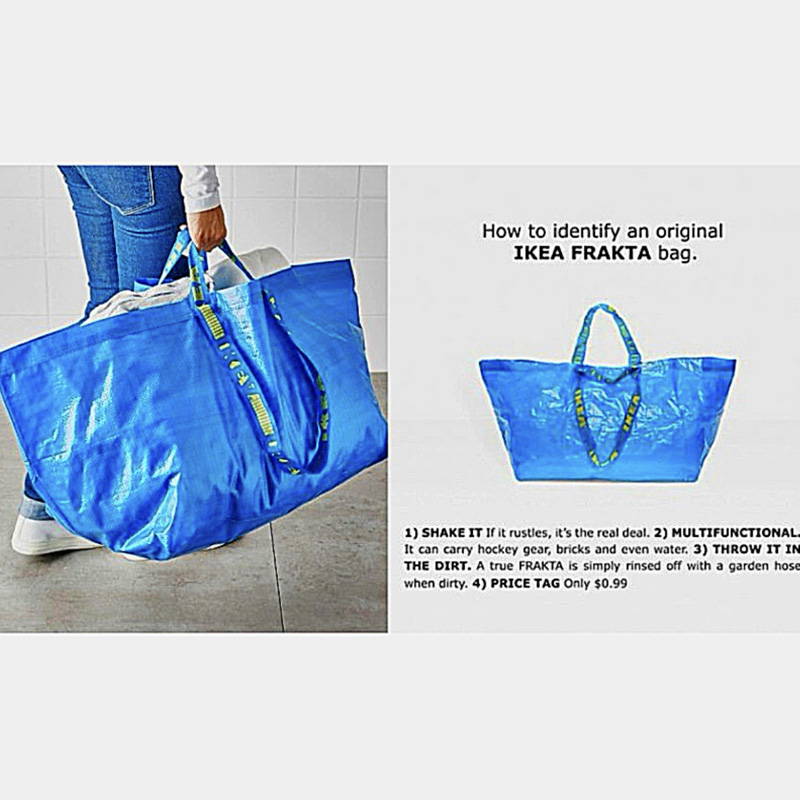

SACS À MAIN ÉTHIQUES ET DURABLES
Sac cabas Marco Trevisan en toile de coton biologique et cuir tanné végétal sans tannins synthétiques ni chrome
La mode durable est une tendance qui implique de plus en plus l'industrie textile et du cuir – l'un des secteurs ayant le plus grand impact environnemental. C'est un processus de promotion du changement dans la fabrication des vêtements, dans les processus de production, et dans l'élimination des articles en fin de cycle de vie.
Le résultat est un domaine de recherche extrêmement intéressant et éthique qui se concentre sur l'étude de composants innovants respectueux de l'environnement.
Aujourd'hui, nous sommes tous bien plus conscients écologiquement et responsables qu'auparavant, et une grande partie de nos choix et achats reflète notre plus grand niveau de sensibilité à ces enjeux. Nous sommes mieux préparés et savons reconnaître les matières premières qui polluent moins. Nous comprenons comment économiser l'eau et l'électricité dans les coûts de production, et nous cherchons à recycler les déchets autant que possible.
Il n'y a pas d'alternatives si nous voulons éviter d'autres dommages à notre planète.
GESTES DE SOLIDARITÉ POUR L'ENGAGEMENT CULTUREL
En farsi et en pachto – les deux langues officielles en Afghanistan – « gul » signifie fleur, et en farsi « dusi » signifie broderie. Le terme « guldusi » est utilisé par les femmes pour tous types de broderie à la main. De nombreuses femmes vivant dans les zones rurales d'Afghanistan sont des brodeuses très qualifiées. L'objectif est de leur offrir la possibilité de générer des revenus grâce à leurs compétences en broderie tout en garantissant que la broderie traditionnelle à la main continue de faire partie de leur riche patrimoine.
L'idée est d'aider ces œuvres d'art à être appréciées et achetées pour des maisons en dehors de l'Afghanistan. Lorsque des personnes dans d'autres parties du monde découvrent ces pièces et les intègrent dans leur propre travail textile, deux cultures se rencontrent et génèrent un nouvel art. Acheter ces chefs-d'œuvre signifie être un ambassadeur et respecter l'identité culturelle.

Sac traditionnel afghan avec broderie pachtoune de la province de Katawaz

QUI SE CACHE DERRIÈRE LA LISTE ?
Antonella Dedini est une architecte italienne, une designer d'intérieur et professeure universitaire.
En tant que curatrice de design, elle a fondé le Milano Design Film Festival, un événement reconnu internationalement qu'elle a co-curaté jusqu'en 2019. De plus, elle est l'auteure éditoriale d'un profil Instagram unique et atypique nommé Deden Design List, fondé en septembre 2020, pour prouver que le bon Design améliore votre vie.
Depuis le 1er août 2021, elle collabore avec Design Italy pour établir une liste mensuelle par catégorie d'objets, de thèmes et d'espaces.
La Liste est une sélection éditoriale thématique d'environ 20 photos.
Gardons un œil sur la sélection d'Antonella chaque mois.






